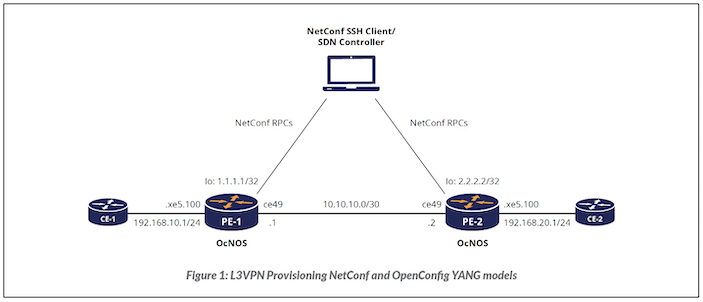
With its support for OpenConfig, IP Infusion’s OcNOS® makes it easier for network designers and orchestrators to set up complex 4G/5G telecom networks.
OcNOS, a disaggregated network operating system, allows network designers to have more creativity, customizability and flexibility while designing their networks, while simultaneously saving themselves and their company considerable time and money.
Traditional network architecture has been rigid and inflexible by forcing systems to be locked into management software depending on what equipment they use. Currently, network equipment vendors have their own Command Line Interfaces, or CLIs, used to manage their network nodes. These CLIs are written to be unique to each vendor and are necessary pieces of software for network designers to interact with and configure their systems.
As a result, if a service provider company is using traditional Tier 1 vendor solutions, for example, to drive some of their network architecture, they have only one of two options to manage their network:
- They either must fully commit to building their network with a Tier 1 vendor’s integrated software and hardware solution; or
- They can pursue the time-consuming and costly endeavor of applying layer after layer of different management software to their design to accommodate hardware from each vendor supporting their network. Even after doing so, the time they would spend sifting through layers each time they have to troubleshoot or reconfigure is unquantifiable. Simple Network Management Protocol (SNMP) was created to accommodate this issue, but it’s limited to simply monitoring the network and doesn’t offer nearly the same malleability as the vendors’ proprietary CLI. NetConf has emerged as an alternative network protocol, providing a one-stop solution for configuration, monitoring and telemetry. Gone are the traditional methods of network architecture and design.
Disaggregation Means Network Design Flexibility
Disaggregated networks now offer the key to the modernization of network solutions. Disaggregation allows network nodes to be decoupled from their specific components and completely revamp how network designers can approach their individual solutions. Instead of the traditional approach requiring the system to be integrated with the same vendor supporting all of devices top-to-bottom, disaggregated networks allow for multiple vendors. A vertical disaggregation approach is where nodes in an end-to-end telecom network can come from different vendors, providing the operator the choice of best-of-breed based on his specific requirements. With a horizontal approach, software and hardware are decoupled, allowing the software to come from any network operating system vendor and the hardware from any original design manufacturer.
The modularity accommodated by disaggregated networks is revolutionary as it allows orchestrators to have total control over each network component. They can now “shop around” for whatever equipment best suits their own needs rather than having to commit to one vendor over another. Because of this, network systems have the ability to be uber-efficient and catered much more specifically than ever before. This modularity also allows for accelerated scalability as new nodes can be added on an as-needed basis much more easily than ever before.
Seamless Module Communication With NetConf/YANG for OpenConfig
For more than 20 years, IP Infusion has been leading the charge in innovative network solutions with their technology. Now, with the addition of OpenConfig, OcNOS provides a standards-based North-bound interface to seamlessly interact with open software-defined networking (SDN) controllers.
“OpenConfig is an informal working group of network operators sharing the goal of moving their networks towards a more dynamic, programmable infrastructure by adopting software-defined networking principles such as declarative configuration and model-driven management and operations. OpenConfig models are vendor-neutral data models defined in YANG. They cover actual operational needs from the use cases and requirements from multiple network operators.” — openconfig.net
With OpenConfig’s standard interface, designers can now setup networks simply and with flexibility. They can optimize their network to accommodate whatever resources they so choose without worry of the vendor lock-in of the past. Because the software allows for a network with multi-vendor nodes, time and money no longer need to be spent on integrating network controllers to numerous devices. OpenConfig provides the capability of communicating with multi-vendor devices using a single standard interface.
Additionally, because it is no longer necessary to purchase the “bundled” packages of network management software with each new equipment module, designers can now renegotiate the price of purchases from providers.
The scalable models utilized as part of the OpenConfig support are not limited to the standardized designs as those published by the Internet Engineering Task Force (IETF). Instead, IP Infusion has based its YANG models on the operational needs from multi-vendor use cases. It’s for this reason that it’s an ideal solution for systems dealing with considerable vendors.
After OpenConfig’s data models have “translated” the vendor’s proprietary data model schema, NetConf’s management interfaces will provide all the same options and resources that would be available in the equipment’s native CLI.
IP Infusion continues to enhance its OpenConfig data model support with each release. As more and more data models are being standardized by IETF, it is enabling network orchestrators to add further capabilities to the applications communicating with the Network Equipment.
Disaggregated networks are the next step in the evolution of network architecture. Any network designer or orchestrator looking to modernize their network should move towards implementing OpenConfig data models in their system. This will allow them to break free of the inflexible shackles currently locking their equipment to vendor-provided software.
Contact IP Infusion to learn more about disaggregated network solutions and OcNOS. Download IP Infusion’s OcNOS OpenConfig Application Note here.

